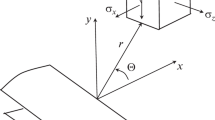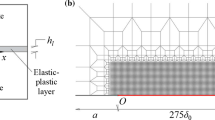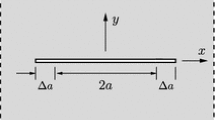Abstract
Fracture surface interactions, of whatever origin, can significantly affect the stress intensity factor, and consequently, can also be relevant to fatigue crack propagation. In the occurrence of interaction between fracture surfaces, the effective loading cycle experienced by material near the crack tip may be very different from that evaluated on the basis of the external loadings only. The purpose of the work described in this paper is to obtain the effective mode II stress intensity factor, k IIeff, in a surface cracked elasto-plastic plate with a factory roof fracture surface subjected to an in-plane shear (mode II) loading. A new model estimating the magnitude of the frictional mode II stress intensity factor, k f, arising from the mismatch of the fracture surface roughness during in-plane shear, is developed. Furthermore, the results of this study are employed in modeling the fatigue response of the surface cracked plates subjected to mixed mode loading.
Similar content being viewed by others
References
R. Ballarini M.E. Plesha (1987) ArticleTitleThe effects of crack surface friction and roughness on crack tip stress fields International Journal of Fracture 34 IssueID3 195–207 Occurrence Handle10.1007/BF00019717
R. Becker (1998) ArticleTitleEffects of strain localization on surface roughening during sheet forming Acta Materialia 46 IssueID4 1385–1401 Occurrence Handle10.1016/S1359-6454(97)00182-1
L.C. Bian K.S. Kim (2004) ArticleTitleThe minimum plastic zone radius criterion for crack initiation direction applied to surface cracks and through-cracks under mixed mode loading International Journal of Fatigue 26 IssueID11 1169–1178 Occurrence Handle1115.74362 Occurrence Handle10.1016/j.ijfatigue.2004.04.006
F.P. Bowden D. Tabor (1967) Friction and Lubrication of Solids NumberInSeriesVol. II Oxford University Press London, UK
F.P. Bowden D. Tabor (1986) The Friction and Lubrication of Solids Oxford Science Publisher UK 322
J.H. Bulloch (1992) ArticleTitleEffects of mean stress on the threshold fatigue crack extension rates of two spheroidal graphite cast irons Theoretical and Applied Fracture Mechanics 18 15–30 Occurrence Handle10.1016/0167-8442(92)90003-G
Coffin, L.F. (1978). Fatigue in machines and structures-Power generation. In Fatigue and Microstructure. ASM, pp. 4–7
M. Comninou J. Dundurs (1979) ArticleTitleOn the frictional contact in crack analysis Engineering Fracture Mechanics 12 IssueID1 117–123 Occurrence Handle10.1016/0013-7944(79)90068-7
R.J. Cooke P.E. Irving G.S. Booth C.J. Beevers (1975) ArticleTitleThe slow fatigue crack growth and threshold behaviour of a medium carbon alloy steel in air and vacuum Engineering Fracture Mechanics 7 IssueID1 69–77 Occurrence Handle10.1016/0013-7944(75)90067-3
N. Egami S. Kitaoka (1996) ArticleTitleMixed mode fatigue crack thresholds from bending and cyclic torsion of a plate Fatigue & Fracture of Engineering Materials and Structures 19 IssueID5 551–560
A.G. Evans J.W. Hutchinson (1989) ArticleTitleEffects of non-planarity on the mixed mode fracture resistance of bimaterial interfaces Acta Metallurgica 37 IssueID3 909–916 Occurrence Handle10.1016/0001-6160(89)90017-5
K. Gall H. Sehitoglu Y. Kadioglu (1996) ArticleTitleFEM study of fatigue crack closure under double slip Acta Materialia 44 IssueID10 3955–3965 Occurrence Handle10.1016/S1359-6454(96)00049-3
R.U. Goulet T.S. Gross D.A. Mendelson (1996) ArticleTitleEvidence of fracture surface interference for cracks loaded in shear detected by phase-shifted speckle interferometry Metallurgical and Materials Transactions A 27A 3852–3860 Occurrence Handle1996MMTA...27.3853G
T.S. Gross D.A. Mendelsohn (1988) ArticleTitleOn the effect of crack face contact and friction due to fracture surface roughness in edge cracks subjected to external shear Engineering Fracture Mechanics 31 IssueID3 405–420 Occurrence Handle10.1016/0013-7944(88)90084-7
Gross T.S. and Mendelsohn D.A. (1989). Mode I stress intensity factors induced by fracture surface roughness under pure mode III loading: application to the effect of loading modes on stress corrosion crack growth. Metallurgical and Materials Transactions A 20A:1989–1999.
M.M.I. Hammouda A.S. Fayed H.E.M. Sallam (2003) ArticleTitleSimulation of mixed mode I/II cyclic deformation at the tip of a short kinked inclined crack with frictional surfaces International Journal of Fatigue 25 IssueID8 743–753 Occurrence Handle10.1016/S0142-1123(03)00047-1
D.Y. Jeong (1995) ArticleTitleApplication of effective stress intensity factor crack closure model to evaluate train load sequence effects on crack growth rates Theoretical and Applied Fracture Mechanics 22 43–50 Occurrence Handle10.1016/0167-8442(94)00047-5
D.N. Lal V. Weiss (1978) Metellurgical Transactions 9A 413–426 Occurrence Handle1978MTA.....9..413L
B.R. Lawn (1993) Fracture of Brittle Solids EditionNumber2 Cambridge University Press UK
S.W. Lo T.C. Hong (1999) ArticleTitleSurface roughening and contact behavior informing of aluminum sheet Journal of Tribology 121 IssueID2 224–233
Lugg, M.C. (1992). An Introduction to AC Potential Drop (ACPD). Technical Software Consultants Ltd., United Kingdom.
D.A. Mendelsohn K.H. Wang (1988) ArticleTitlePartial release and relocking of a frictionally locked crack due to moving tensile loads Journal of Applied Mechanics 55 383–388 Occurrence Handle10.1115/1.3173687
H. Nayeb-Hashemi F.A. McClintock (1982) ArticleTitleEffects of friction and high torque on fatigue crack propagation in mode III Metallurgical and Materials Transactions A 13 IssueID12 2197–2204
H. Nayeb-Hashemi F.A. McClintock (1983) ArticleTitleInfluenece of overloads and block loading sequences on mode III fatigue crack propagation in A469 rotor steel Engineering Fracture Mechanics 18 IssueID4 763–783 Occurrence Handle10.1016/0013-7944(83)90123-6
H. Nayeb-Hashemi F.A. McClintock R.O. Ritchie (1982) ArticleTitleEffects of friction and high torque on fatigue crack propagation in mode III Metallurgical and Materials Transactions A 18A 2197–2204 Occurrence Handle1982MTA....13.2197N
H. Nayeb-Hashemi F.A. McClintock R.O. Ritchie (1983) ArticleTitleMicro-mechanical modeling of mode III fatigue crack growth in rotor steels International Journal of Fracture 23 IssueID3 163–185 Occurrence Handle10.1007/BF00028821
P.C. Paris F.A. Erdogan (1963) ArticleTitlecritical analysis of crack propagation laws Journal of Basic Engineering D 85 528–539
N.K. Ramakrishna Naidu S. Ganesh Sundara Raman (2005) ArticleTitleEffect of contact pressure on fretting fatigue behaviour of Al–Mg–Si alloy AA6061 International Journal of Fatigue 27 IssueID3 283–291 Occurrence Handle10.1016/j.ijfatigue.2004.07.001
A.C. Reardon D.J. Quesnel (1995) ArticleTitleFracture surface interference effects in mode III Mechanics of Materials 19 IssueID2-3 213–226 Occurrence Handle10.1016/0167-6636(94)00039-J
Rice, J.R. (1968). Mathematical analysis in the mechanics of fracture. In Fracture: An Advanced Treatise – Vol. 11 (edited by Liebowitz, H.). Academic Press, New York, USA, pp. 214–223.
Rice, J.R. (1969). Mathematical analysis in the mechanics of fracture. In fracture of solids: fracture of solids – Vol. 2 (Edited by Liebowitz, H.). Academic Press, New York, USA, pp. 218–221.
R.O. Ritchie F.A. McClintock H. Nayeb-Hashemi M.A. Rittler (1982) ArticleTitleMode III fatigue crack propagation in low alloy steel Metallurgical and Materials Transactions A 13A IssueID1 101–110 Occurrence Handle1982MTA....13..101R
Sih, G.C. (1975). Three dimensional crack problems. In: Mechanics of Fracture 2, Noordhoff, Netherlands.
A.K. Soh L.C. Bian (2001) ArticleTitleMixed mode fatigue crack growth criteria International Journal of Fatigue 23 IssueID5 427–439 Occurrence Handle10.1016/S0142-1123(00)00105-5
K. Tanaka Y. Akiniwa H. Nakamura (1996) ArticleTitleJ-integral approach to mode III fatigue crack propagation in steel under torsional loading Fatigue & Fracture of Engineering Materials and Structures 19 IssueID5 571–579
J. Tong J.R. Yates M.W. Brown (1995a) ArticleTitleA model for sliding mode crack closure part I: Theory for pure mode II loading Engineering Fracture Mechanics 52 IssueID4 599–611 Occurrence Handle10.1016/0013-7944(95)00044-V
J. Tong J.R. Yates M.W. Brown (1995b) ArticleTitleA model for sliding mode crack closure part II: mixed mode I and II loading and application Engineering Fracture Mechanics 52 IssueID4 613–621 Occurrence Handle10.1016/0013-7944(95)00045-W
E.K. Tschegg (1982) ArticleTitleThe influence of the static I load mode and R ratio on mode III fatigue crack growth behavior in mild steel Materials Science and Engineering: A 54 127–137 Occurrence Handle10.1016/0025-5416(82)90037-4
E.K. Tschegg (1983) ArticleTitleA contribution to mode III fatigue crack propagation Materials Science and Engineering: A 59 127–136 Occurrence Handle10.1016/0025-5416(83)90094-0
E.K. Tschegg (1984) ArticleTitleSliding mode crack closure and mode III fatigue crack growth in mild steel Acta Metallurgica 31 IssueID9 1323–1330 Occurrence Handle10.1016/0001-6160(83)90003-2
N.J. Wittridge R.D. Knutsen (1999) ArticleTitleA microtexture based analysis of the surface roughening behavior of an aluminum alloy during tensile deformation Materials Science and Engineering: A 269 IssueID2 205–216 Occurrence Handle10.1016/S0921-5093(99)00145-8
Yates, J.R. and Mohammed, R.A. (1994). Crack propagation under mixed mode (I+III) loading. Proceedings of the Fourth International Conference on Biaxial/Multiaxial Fatigue, Saint-Germain-en-Laye, France, Vol. II, pp. 99–106.
Author information
Authors and Affiliations
Corresponding author
Rights and permissions
About this article
Cite this article
Bian, LC., Fawaz, Z. & Behdinan, K. A mixed mode crack growth model taking account of fracture surface contact and friction. Int J Fract 139, 39–58 (2006). https://doi.org/10.1007/s10704-006-6633-0
Received:
Accepted:
Issue Date:
DOI: https://doi.org/10.1007/s10704-006-6633-0




